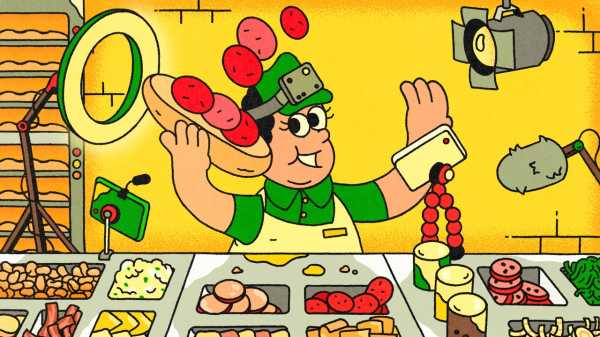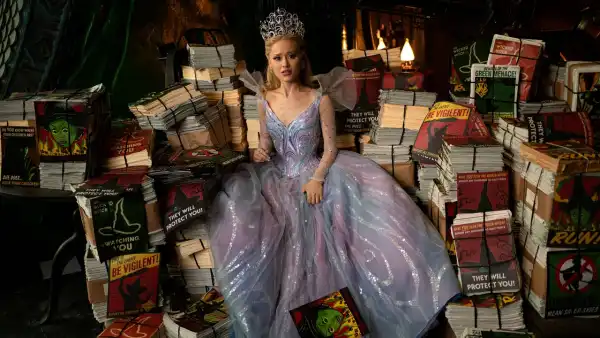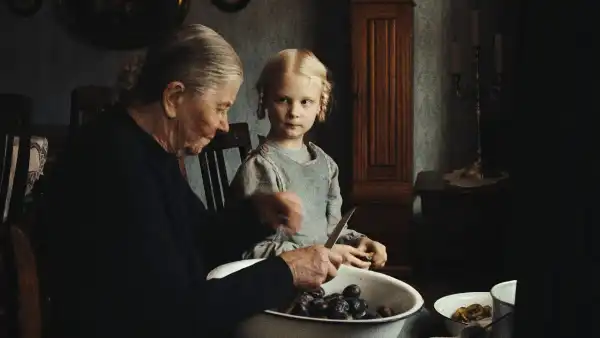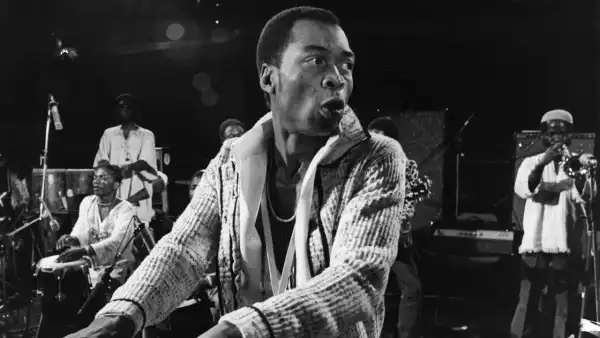
Before Milad Mirghahari began posting videos on TikTok, he didn’t know his job at Subway could be deeply captivating to millions of people. His parents, both immigrants from Iran, bought their first Subway franchise more than twenty years ago, and later opened a second store in Cedar Grove, New Jersey, near their home. After school, Mirghahari would eat a sandwich while his older brothers worked. At sixteen, he followed their lead and took an official part-time position.
When the pandemic began, life became very boring for the twenty-year-old New Jersey Institute of Technology student and sandwich artist. With many people unwilling to venture inside for a sub of remarkable length, Mirghahari amused himself by making TikToks. He discovered that people were more impressed by the location of his videos than by the content. “Bruh you’re at subway,” someone commented, on a tribute that he had made to his parents for creating a better life for him and his siblings in the United States. “Bruh that’s a subway,” another observed.
One day, someone placed an order in the comments: “Lemme get an Italian BMT with lettuce, tomato, onions, oil, vinegar, salt, pepper, oregano, and chipotle sauce.” Mirghahari thought the request was hilarious, so he filmed a point-of-view video of himself making the sandwich, layering spicy pepperoni, Genoa salami, and Black Forest ham on a six-inch sub. The comments section could hardly believe the exceptional nature of what had just occurred; requests for sandwiches flooded in. Some ordered staples (Spicy Italian, chicken teriyaki, turkey). Others thought of the least appetizing combinations possible (just lettuce plus every sauce, or several Subway cookies on a sub) and encouraged him to eat them. Mirghahari developed a video formula: identify the sandwich, make it, eat it, review it. “And that worked for a long time,” he told me.
As his channel grew, he fulfilled requests from the Los Angeles Clippers basketball franchise (buffalo chicken), the Chicago Bulls mascot Benny the Bull (turkey and bacon on herb-and-cheese bread), and the skateboarding legend Tony Hawk (chicken parmesan). When eating several sandwiches a day proved burdensome, he began to record himself preparing orders for customers while answering viewer-submitted questions. Which sandwich did he recommend for someone who had never been to Subway? Had he ever fallen in love with a customer? Had anyone died in his store? By the end of 2020, Mirghahari was receiving between a few hundred thousand and several million views per video. About two years later, with nearly six million TikTok subscribers and four million more on YouTube, he had enough money to buy the Subway from his parents.
Mirghahari was following an example developed and perfected by Dylan Lemay when Lemay was a twenty-three-year-old manager at a Cold Stone Creamery. Lemay had taken his first job as a cake decorator at the chain when he was fifteen. A native of Taylor, Michigan, with light-brown hair and a somniferous voice, he was an excellent fit for the role: enthusiastic, creative, dessert-loving. “That’s like a dream job for anyone,” he gushed. “And then I got to make my own schedule on top of that.” Part of his college search entailed seeking out nearby Cold Stones. When he told a store manager in Springfield, Missouri, that he had two years of cake-decorating experience and was likely attending school nearby, she gasped. “You just saved my life,” she told him. Her cake decorator had just left; she hired him on the spot.
The steady job at the design-your-own-ice-cream chain became a source of teasing for his friends at Baptist Bible College. “They were pretty much telling me that they were going to come back in a couple years and I was still gonna be working at Cold Stone,” he said. Graduation was an inflection point. Though Lemay had enjoyed learning more about the Christian faith in which he was raised, he lacked interest in a related career. What he really enjoyed was making people’s day a little better—building and decorating a birthday cake for a child and seeing her fall in love with it, being part of special moments in his customers’ lives. But sticking with the position invited ridicule. “When you go through, you graduate high school, you graduate college, and you’re still doing the same job that you did when you were fifteen, it doesn’t look good from the outside,” Lemay told me. “It sounds like you’re kind of failing at life.”
After speaking to a mentor, who said there was nothing wrong with staying at Cold Stone, he decided to give it a try. Upon graduation, he rented an apartment and began a full-time managerial role. The pandemic forced almost all of his college-aged employees back home, but within a few months the staff had stabilized. One of his co-workers entered the summer with the goal of becoming TikTok famous. It made some sense; videos of Cold Stone employees making ice cream, mixing toppings, and opening the store for business had been going unexpectedly viral. He decided to help her along while business was slow.
As Lemay studied the kinds of videos that were trending, he received unexpected inspiration from a friend who, owing to an inability to cook, claimed he wouldn’t survive the pandemic. Lemay decided to help him out with a joke instructional video. He tucked a small tripod into his shirt and pointed his iPhone down from just below eye level, capturing his hands as he made hash and eggs. He realized he was onto something. He began recording videos at work in a similar style, providing a first-person view of his life from the other side of the counter. “Today’s your first day working here at Cold Stone,” he said, in a pseudo employee-training video, gazing at the mysterious world just out of view for millions of ice-cream consumers. “I need you to put on your apron and your hat. Now you’re gonna wash your hands.” His entry into the video genre received more than ten million views. The questions rolled in: Has a hater ever tried to get him fired? Who pays for dropped ice cream? How does he film his videos? Lemay soon had a million subscribers. He hooked viewers with a seemingly endless trove of work stories and the narrative drama inherent in watching someone mix vanilla ice cream, Sour Patch Kids, and Sour Skittles.
By the end of 2020, TikTok was awash in behind-the-scenes content from popular chains: Lemay scooping up ice cream and performing his trademark toss into customers’ bowls; Mirghahari making a meatball parmesan and describing a scuffle between two schoolchildren in his Subway line; the Dairy Queen employee Morgann Book copying a customer’s Kit Kat, banana, and caramel Blizzard order and making it for herself. As the top fast-food creators began posting their videos on YouTube—the platform’s revenue-sharing model paid much more than TikTok’s diluted Creator Fund—making these videos became a profit source, and a boost to their franchises. In March and April of 2021, the daily sales in Mirghahari’s Cedar Grove Subway more than doubled from an average pre-pandemic day, with seemingly everyone in the restaurant knowing about the videos. His parents, who had not really understood what he was doing, caught on after repeatedly being told by customers.
The pandemic created ideal conditions for making videos at work. With fewer customers in stores, employees faced less scrutiny as they wrapped cameras around their necks and recorded themselves making food. (Or, in the barista Rocio Najera’s case, directing a nineteen-part “Starbucks Love Story” TikTok soap opera with co-workers.) About three million Americans work in the fast-food industry, but, for the more than third of American adults who eat fast food every day, these chains are both exceedingly familiar and shrouded in mystique. On countless road trips, I have consumed Subway’s Cold Cut Combo—a sandwich composed of “salami,” “ham,” and “bologna” that are, inexplicably, each made of turkey. And, although I had requested each ingredient and watched someone assemble them, step by step, I had never experienced the construction from the other side of the glass. When I saw Mirghahari’s videos, I was transfixed. Sure, it’s epistemologically interesting to watch the show “How It’s Made” explain the origins of a stretch limousine, but I probably will never ride in one. The highly processed and objectively mediocre Cold Cut Combo conjures up my happiest childhood memories.
And, although fast-food jobs are perhaps the most commonly mocked career path in the country, what quickly becomes obvious is that they are, at the very least, much more interesting on a daily basis than most careers. A Strawberry Cheesecake Blizzard cake from Dairy Queen can form the narrative arc of multiple videos. An hour-long lunch rush at McDonald’s can turn into a live stream. Some of the worst parts about working a service job—customers stealing from the tip jar, berating employees, and complaining about prices—can inspire stories that draw millions of views. Even without customers, there’s generally a co-worker around who can act as an ad-hoc producer or onscreen talent. Any one of hundreds of comments can be answered in a video, spurring hundreds of comments on the next. As long as people enter their stores and place orders, fast-food TikTokers have an endless content supply.
Many trends stick around for a day or two, but fast-food TikTok has remained a stable presence across Instagram, TikTok, and YouTube. “I feel like, if this were five years ago, there’s no way that this is making it past a month,” Mirghahari told me. “But, because of the way the Internet is structured now, there’s a community for everything.” For those at the top, the attention can turn notoriously low-paying jobs into a comfortable career. Mirghahari, with money earned from YouTube advertisements, recently gave his mother a check for a hundred thousand dollars.
Lemay took a different path. With money from YouTube and 1.5 million dollars in investments, he opened his own ice-cream shop in Manhattan, on Bleecker Street. In contrast to made-for-Instagram museums and installations, the new store, Catch’N Ice Cream, is decidedly made for TikTok. On a slow Thursday afternoon, Lemay stared intently as an employee grabbed a cookie-dough-encased ball of vanilla ice cream with a pair of spades and flung it to his partner behind the counter—a play on Lemay’s signature ice-cream throws. The customers who knew the drill walked into Catch’N Ice Cream with their phones out, ready to record the spectacle.
Freed from his behind-the-counter duties at Cold Stone, Lemay is responsible for his new shop’s creative vision: recruiting employees, developing flavors, improving the customer experience. And, with more than fifteen million followers across TikTok and YouTube, he also has to promote his business. It doesn’t feel right to show up, do some recording, and then leave. He wants to sweep the floor, check on the temperature of a freezer, and wipe stray condensation off the display glass. “And then I just get so sidetracked with so many things that I just kind of kill the creativity sometimes, if I’m not careful,” he told me, a few feet from the counter. “My job should be making this content.” Hundreds of millions have watched him perfect the audio-visual experience of making ice cream. Time will tell if they want to eat it, too. ♦
Sourse: newyorker.com






